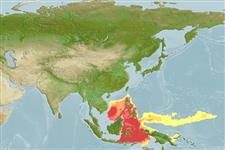>
Anguilliformes (Eels and morays) >
Ophichthidae (Snake eels) > Myrophinae
Etymology: Benthenchelys: Greek, benthos = depth of the sea + Greek, enchelys, -yos = eel (Ref. 45335).
Eponymy: Oscar Cartier was a German herpetologist and ichthyologist who was at the University of Wurzburg, which published his thesis (1872). [...] (Ref. 128868), visit book page.
More on author: Fowler.
Environment: milieu / climate zone / depth range / distribution range
Ecologia
marinhas batipelágico; intervalo de profundidade ? - 1168 m (Ref. 58018). Tropical
Western Central Pacific: Philippines.
Tamanho / Peso / Idade
Maturity: Lm ? range ? - ? cm
Max length : 9.6 cm SL macho/indeterminado; (Ref. 31667)
Members of the genus Benthenchelys are pelagic (Ref. 39782).
Ciclo de vida ou comportamento de acasalamento
Maturidade | Reprodução | Desova | Ovos | Fecundidade | Larvas
Smith, D.G. and J.E. McCosker, 1997. Ophichthidae. Snake eels, worm eels. p. 1662-1669. In K.E. Carpenter and V.H. Niem (eds.) FAO species identification guide for fishery purposes. The living marine resources of the WCP. Vol. 3. Batoid fishes, chimaeras and bony fishes part 1 (Elopidae to Linophrynidae). FAO, Rome. (Ref. 39782)
Status na Lista Vermelha da UICN (Ref. 130435: Version 2024-1)
Ameaça para os humanos
Harmless
Uso pelos humanos
Ferramentas
Relatórios especiais
Baixar XML
Fontes da internet
Estimates based on models
Preferred temperature (Ref.
123201): 6.8 - 11.1, mean 10.2 °C (based on 39 cells).
Índice de diversidade filogenética (Ref.
82804): PD
50 = 0.6250 [Uniqueness, from 0.5 = low to 2.0 = high].
Bayesian length-weight: a=0.00076 (0.00029 - 0.00197), b=3.06 (2.83 - 3.29), in cm total length, based on LWR estimates for this (Sub)family-body shape (Ref.
93245).
Nível Trófico (Ref.
69278): 3.7 ±0.6 se; based on size and trophs of closest relatives
Resiliência (Ref.
120179): Elevada, tempo mínimo de duplicação da população menor que 15 meses (Preliminary K or Fecundity.).
Fishing Vulnerability (Ref.
59153): Low vulnerability (10 of 100).
